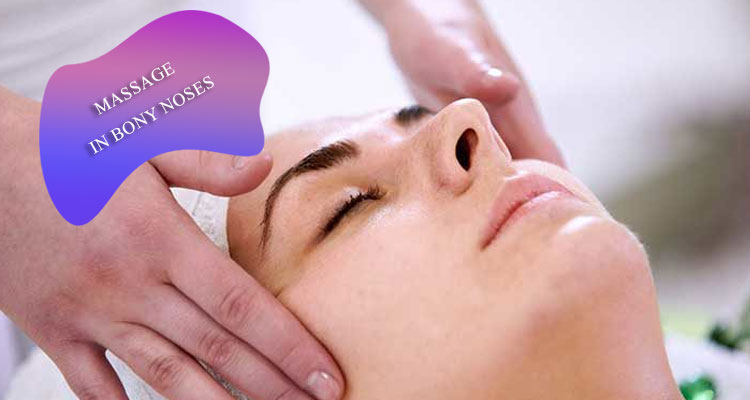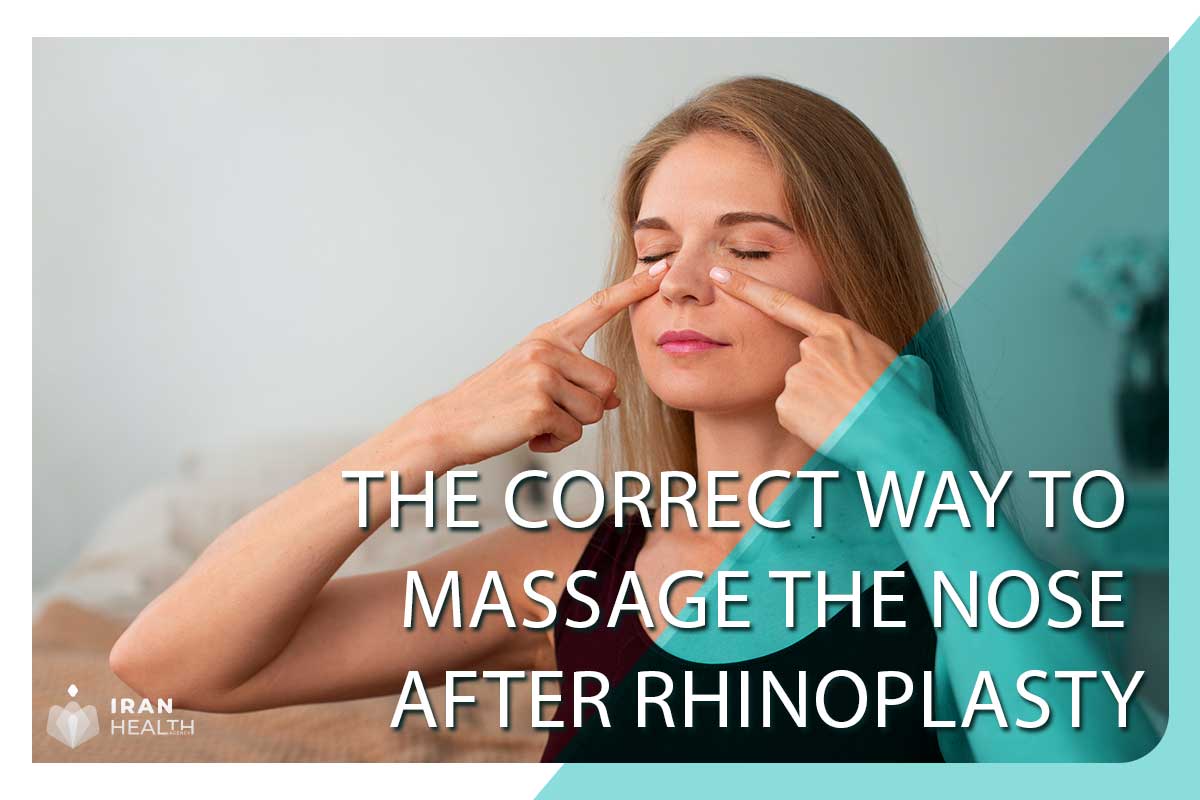The correct way to massage the nose after rhinoplasty is integral to recovery. Following nasal surgery, gentle massage techniques can help reduce swelling, minimize scar tissue formation, and improve the final contours of the nose. However, nasal massage must be done carefully and correctly to avoid complications like infection, bleeding, or disruption of the surgical results. This article will discuss the proper techniques, timing, precautions, and benefits of post-rhinoplasty nasal massage. Knowing the correct way to massage the nose after a nose job can help patients optimize their healing and enhance their final cosmetic outcomes. With surgeon approval and by following some simple guidelines, massage can be integrated into the post-op regimen for rhinoplasty patients.
see more: nose job surgery in iran
How to massage your nose after a rhinoplasty procedure?
Here are some tips for massaging the nose after a rhinoplasty procedure:
- Wait at least 3-4 weeks after surgery before beginning the massage. This allows initial swelling and bruising to subside.
- Wash your hands thoroughly before massaging to prevent infection.
- Use a gentle moisturizer or massage oil to massage the skin. This prevents tugging on the delicate nasal tissues.
- Apply light pressure in small circular motions. Avoid pressing too hard or massaging aggressively.
- Focus on massaging the sides of the nose and bridge area. Avoid directly massaging the nasal tip early on as it is very delicate after surgery.
- Massage 5-10 minutes per session, 1-2 times daily. Consistency is key.
- Always follow your surgeon’s specific post-op instructions on when to start massage and how often to do it. Don’t massage against medical advice.
- Stop immediately if you experience increased swelling, bruising, fluid leakage, numbness, or pain. Report any concerning symptoms to your surgeon.
- Be extremely gentle around the nasal bones and any osteotomy sites. These areas take longer to heal.
- Patience is important. It can take several months to complete swelling resolution and final rhinoplasty results.
Consistency with gentle massage techniques can help reduce post-op swelling and may improve nasal contouring over time. But always check with your plastic surgeon first before starting any massage regimen.
Three Types of post-surgery nasal massage
Here are three main types of nasal massage techniques commonly used after rhinoplasty surgery:
- Effleurage
- This involves gentle, light strokes along the length of the nose. Use fingernails or fingertips to glide over the skin surface softly.
- Helps improve blood circulation and drainage to reduce swelling.
- Petrissage
- Uses kneading motions to compress and release tissues along the nasal bridge and sides of the nose.
- It can help break up internal scar tissue and contour irregularities.
- Friction
- Deep circular motions are applied along the nasal bones and cartilage structures.
- Helps smooth out adhesions and loosen stiff tissues.
Other tips:
- Always follow the surgeon’s instructions on when to start massage and post-op precautions.
- Use a lubricant like a vitamin E oil to allow smooth gliding motion.
- Start very gently and increase pressure gradually as healing allows.
- Avoid directly massaging the nasal tip initially.
- Massage both sides of the nose and bridge for equal healing.
- Work from the upper part of the nose downwards.
- Repeat daily massage sessions for several months for best results.
- Adjust pressure based on your pain tolerance.
- Stop immediately if you experience sharp pain, pinching, bleeding or other concerns.
Consistency is vital with post-rhinoplasty massage techniques. When done correctly, it can help optimize nasal contour and aesthetics after surgery.

Techniques for adequately massaging the nose after a rhinoplasty:
Here are some step-by-step techniques for properly massaging the nose after a rhinoplasty:
Preparation:
- Wash your hands thoroughly with soap and water to sanitize.
- Ensure your face is clean. Use a gentle cleaner that won’t irritate the skin.
- Have a moisturizer, vitamin E oil, or other lubricant ready.
Technique:
- Apply a small amount of lubricant to your fingertips. This allows them to glide smoothly.
- Begin with very light pressure. Start at the top of the bridge and work down the sides.
- Use your index fingers to massage with circular motions gently. Follow the contour of the bones and cartilage.
- Gradually increase pressure, but remain gentle. The tissues will be sensitive post-surgery.
- Spend extra time massaging any swollen or stiff areas to break up scar tissue. But avoid directly manipulating the tip early on.
- After a few weeks, you can begin massaging the nasal tip carefully following your surgeon’s guidance.
- Continue making circular motions all around the nostrils, bridge, and sides. Repeat on both nasal passages.
- Finish by making long, smooth strokes down the length of the nose to promote drainage.
- Apply additional lubricant if needed. Keep the tissues moist.
- Massage 5-10 minutes 1-2 times daily for best results. Do this consistently for several months.
Always get clearance from your surgeon before beginning a post-rhinoplasty massage. Let pain be your guide, and adjust pressure as needed. Stop if you have concerns or experience sharp pain, pinching, or bleeding. Gentle massage can aid healing, but be cautious.

FAQ:
Here are some of the most frequently asked questions about massaging the nose after rhinoplasty surgery:
When can I start nasal massage after rhinoplasty?
Most surgeons recommend waiting 3-4 weeks after surgery before starting massage. This allows the bones and tissues to stabilize initially.
How often should I massage my nose after surgery?
Massage the nose for 5-10 minutes 1-2 times daily. Consistency is critical for reducing swelling and improving contours.
What is the best technique for nasal massage post-rhinoplasty?
Use light pressure and gentle gliding strokes along the bridge, sides, and tip. Avoid pressing too hard or using scrubbing motions.
Does nasal massage help with swelling and bruising?
Yes, gentle massage can aid drainage and help resolve bruising and swelling more quickly.
Can I massage my nose tip after rhinoplasty?
You can gently massage the nasal tip after a few weeks. Go slowly and avoid this delicate area in the initial healing period.
When will I see the final results after a massage?
It can take up to a year for the nose to fully heal and all swelling to subside. Be patient throughout the massage process.
Is nasal massage painful after rhinoplasty?
There may be some mild tenderness or discomfort. Pain often decreases the longer you consistently massage.
Should I use a lubricant for the massage?
Yes, use a gentle oil or lotion to allow smooth motions over the sensitive nasal tissues.
What are the risks of nasal massage after rhinoplasty?
The main risks are injury, disruption of bones/grafts, infection, and contour irregularities if done too aggressively.
How long should I continue nasal massage techniques?
Most surgeons recommend massaging for at least 3-6 months post-surgery to reduce scar and swelling.



